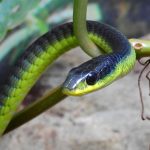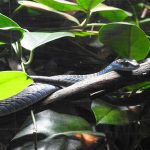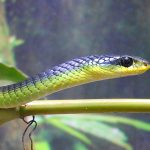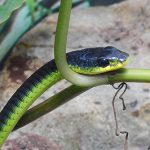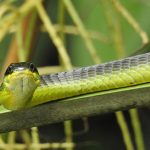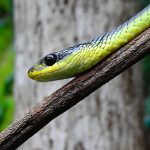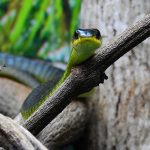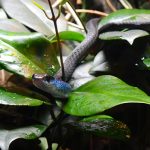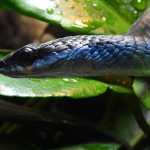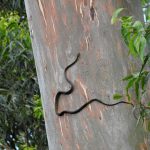GREEN TREE SNAKE
Green Tree Snake
The Green Tree Snake is one of Australia’s most graceful and harmless snakes. Despite the name, it is not always green, and it lives more in shrubs and low trees than high in the canopy. Let’s walk through its life as if you were quietly following one through the bush.
Identification
- Common name: Green Tree Snake
- Scientific name:
Dendrelaphis punctulata - Venom status: Non-venomous to humans (no functional venom glands)
What it looks like
Imagine a very slender ribbon of colour sliding through the leaves:
- Body shape: Long, thin, whippy; often 1–1.5 m, sometimes up to ~2 m
- Head: Small, narrow, with big round eyes that give it a very alert look
- Colour: Extremely variable:
- Olive green, bright green, bluish-green, brown, grey, sometimes almost black
- Many have a bluish tint or sheen along the sides
- Belly: Usually yellow, cream or pale grey; can be vivid yellow near the throat.
- Scales: Smooth and glossy, giving it a shiny, almost polished appearance
When threatened, they may flatten the front of the body, showing flashes of sky-blue skin between the scales. It looks dramatic but is just bluff.
Where It Lives in Australia
The Green Tree Snake is widespread in northern and eastern Australia.
Distribution
You can find it in:
- Queensland: Very common, from the tropical north right down the east coast
- Northern Territory: Top End and surrounding regions
- Western Australia: Northern WA, including the Kimberley region
- New South Wales: Coastal and some inland areas, mainly in the warmer north and east
- Occasionally into far eastern South Australia (rare and localised)
Habitats
It prefers warm, moist, and lightly wooded areas:
- Forests and woodlands
- Rainforest edges and gallery forests along creeks
- Paperbark swamps and wetlands
- Mangroves and coastal scrub
- Suburban gardens, parks and even around houses if there is good vegetation and shelter
Think of it as a snake that likes edges: the edge of water, the edge of forest, the edge of your backyard hedge.
Behaviour and Daily Life
Activity
- Diurnal (active by day): Most often seen basking or hunting in the morning and afternoon
- Often seen:
- Sliding along branches or fences
- Moving quickly through shrubs
- Occasionally crossing paths and roads
They are fast and agile, and usually choose escape over confrontation.
Climbing
Despite the name “tree snake”, many individuals spend a lot of time:
- In low bushes and shrubs
- Among reeds and grasses near water
- On the ground, weaving through leaf litter
They are excellent climbers and will move easily through:
- Hedges
- Vines
- Trees and low branches.
Temperament
- Generally shy and non-aggressive
- If cornered they may:
- Flatten the neck and front body
- Show blue skin between the scales
- Strike defensively with mouth closed or open
They rarely bite, and even when they do, there is no venom danger to people or pets.
Diet: What They Eat
Green Tree Snakes are active hunters with a very useful role in the ecosystem.
Main foods
- Frogs and tadpoles – a major part of their diet
- Small lizards – especially skinks
- Occasionally:
- Small fish in shallow water
- Small mammals and tiny birds or nestlings
- Geckos around houses
They are non-venomous constrictors, but they do not do the tight, long coil like pythons. Instead, they grab and quickly subdue small prey with speed and jaw strength, often swallowing it alive.
Hunting style
- Use sight heavily: those large eyes are always scanning
- Glide quietly through leaves, pausing and flicking the tongue
- Strike quickly and accurately at moving prey
Around garden ponds and frog-friendly backyards, they are often the silent hunter that people never notice.
Life Cycle and Reproduction
Breeding
- Reproduction: Oviparous (egg-laying)
- Breeding season: Warmer months, typically spring to late summer
Females lay:
- Around 5–14 eggs (sometimes a few more)
- In sheltered, warm, humid places like:
- Rotting logs
- Leaf litter
- Soil cavities
- Roof spaces or sheds in suburban areas
Hatchlings
- Tiny versions of the adults, already fast and alert
- Often:
- More brown or grey in colour
- With a more obvious banding or pattern near the head when very young
They are independent from birth and must hunt for themselves immediately.
Similar Species and Misidentification
The Green Tree Snake is often confused with other slender snakes.
Common mix-ups:
Brown Tree Snake (Boiga irregularis)
- Has vertical slit pupils (cat-like), not round
- More patterned and often reddish-brown
- Mildly venomous rear-fanged species (not considered highly dangerous, but not one to handle)
Juvenile Eastern Brown Snake (Pseudonaja textilis)
- Typically more solid brown with less vivid greens or blues
- Head and eye proportions different
- Highly venomous – this confusion is one reason many harmless tree snakes are sadly killed
Correct identification should be left to experienced handlers or herpetologists; if in doubt, simply leave the snake alone and give it space.
Relationship with People
Around homes and gardens
You might notice a Green Tree Snake if you have:
- Dense shrubs or hedges
- Garden ponds or frog-attracting features
- Bird baths, water features, or damp areas
In urban and suburban settings, they are:
- Completely harmless to humans and pets
- Helpful in controlling small rodents.
They often rely on staying unseen; many people live with them in the garden and never realise.
What to do if you see one
- Stay calm, keep a respectful distance
- Do not try to pick it up or corner it
- If it is indoors, open doors/windows and gently encourage it out if safe, or call a licensed snake catcher.
Conservation and Threats
The Green Tree Snake is currently not listed as threatened and is relatively common in many parts of its range. However, it still faces pressures:
Main threats
- Habitat loss: Clearing of forests, wetlands and dense shrub layers
- Road mortality: Being hit while crossing roads in warm weather
- Persecution: Killed by people who mistake them for venomous snakes
- Cats and dogs: Especially for juveniles
- Chemical use: Pesticides and herbicides can indirectly affect them by reducing prey and contaminating habitats
How to help
- Keep some native shrubs and ground cover in your garden
- Avoid or reduce poisons and pesticides
- Drive carefully near wetlands and bush, especially on warm days
- Learn basic snake identification and spread calm, factual information
Living alongside harmless species like the Green Tree Snake helps build a more balanced attitude to all snakes, including the venomous ones that also play important ecological roles.
A Short Field Story
Imagine walking along a creek in coastal Queensland or Northern NSW on a still, warm morning. Dragonflies skim the water, and frogs call softly from the reeds. Out of the corner of your eye you notice something that looks like a twist of green vine moving along a low branch.
You stop. The “vine” pauses too.
A long, slender snake lifts the front of its body, head slightly raised, large eyes bright and curious. Sunlight catches its scales, revealing not just green but a blue shimmer along its sides, and a soft yellow glow on its throat. It studies you briefly, then turns away, flowing soundlessly through the foliage and vanishing into the tangle of leave
In that quiet moment, you have met one of Australia’s most gentle and misunderstood reptiles.

